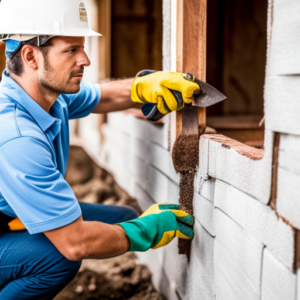A strong and stable foundation is vital for the longevity of your home. However, foundation problems are a common issue that homeowners face. In this comprehensive guide, we will discuss the process of housing foundation repair, common signs of house foundation problems, types of home foundation repair methods, how to fix a shifting house foundation, and more. By the end of this article, you will have the knowledge you need to take the proper steps toward fixing and maintaining a strong housing foundation.
Introduction to Housing Foundation Repair
Housing foundation repair is the process of restoring a damaged or compromised foundation back to its original condition. This is critical for maintaining the structural integrity of your home and preventing further damage. Problems with your home’s foundation can lead to a variety of issues, including uneven floors, cracked walls, and moisture intrusion. By addressing these issues early on, you can save yourself time, money, and stress in the long run.
There are several factors that can contribute to foundation problems, including soil conditions, improper drainage, and natural disasters. Regardless of the cause, it’s essential to identify and address these issues as soon as possible to protect your investment and ensure the safety of your home.
In the following sections, we’ll explore the common signs of house foundation problems, various repair methods, and how to choose the right foundation repair company for your needs.
Common Signs of House Foundation Problems
It’s essential to be aware of the signs that your home may have foundation issues. Early detection can minimize the extent of the damage and the cost of repairs. Some common signs of house foundation problems include:
- Cracks in walls and ceilings: Cracks in your home’s walls and ceilings can indicate foundation issues. While some small cracks are normal, larger or widening cracks are cause for concern.
- Uneven or sloping floors: If you notice that your floors are no longer level or are sloping, this could be a sign of a settling or shifting foundation.
- Doors and windows that stick: When your foundation shifts, it can cause doors and windows to become misaligned, making them difficult to open and close.
- Gaps between walls and floors: If you notice gaps forming between your walls and floors, this may be a sign that your foundation has shifted.
- Bowing or leaning walls: Walls that bow or lean inward may be a result of foundation problems and should be addressed immediately.
If you notice any of these signs, it’s crucial to seek professional help to assess the situation and determine the necessary repairs.
Types of Home Foundation Repair Methods
There are several methods for housing foundation repair, each with its own set of advantages and disadvantages. Some of the most common home foundation repair methods include:
- Piering: This method involves installing steel piers or concrete pilings beneath the foundation to stabilize and lift it. It is a permanent solution and is often considered the most effective method for addressing foundation issues.
- Slabjacking: Slabjacking is a process that involves injecting a mixture of cement, sand, and other materials beneath the foundation to lift and stabilize it. This method is less invasive than piering but may not be suitable for all types of foundations.
- Wall anchors: Wall anchors are used to stabilize and straighten bowing or leaning walls. They are installed in the soil surrounding the foundation and connected to the interior walls with steel plates.
- Carbon fiber straps: Carbon fiber straps are a less invasive method for stabilizing bowing or leaning walls. They are applied to the interior of the wall and secured with epoxy, providing reinforcement and preventing further movement.
The best method for your housing foundation repair will depend on the specific issues you’re facing and the type of foundation you have. A professional foundation repair company can assess your situation and recommend the most appropriate solution.
How to Fix a Shifting House Foundation
A shifting house foundation is a serious issue that can lead to significant structural damage if not addressed promptly. Here are some steps on how to fix a shifting house foundation:
- Identify the cause: The first step in fixing a shifting house foundation is determining the cause of the problem. This may involve consulting with a professional to evaluate the soil conditions, drainage, and other factors that may be contributing to the issue.
- Choose the appropriate repair method: Once you’ve identified the cause of the foundation shift, you’ll need to select the most suitable repair method. This may involve piering, slabjacking, or another technique, depending on your specific situation.
- Hire a professional foundation repair company: Fixing a shifting house foundation is a complex and potentially dangerous process that should be left to the professionals. Look for a reputable company with experience in housing foundation repair to ensure the job is done correctly and safely.
- Monitor the situation: After the repairs are complete, it’s essential to monitor your foundation for any signs of further movement or new issues. Regular inspections can help you catch problems early and prevent the need for more extensive repairs in the future.
Repairing Cracks in the Foundation of a House
Cracks in the foundation of your house can lead to moisture intrusion, pest infestations, and other issues if not repaired promptly. Here are some steps for repairing cracks in the foundation of a house:
- Inspect the crack: Before attempting any repairs, it’s essential to assess the crack to determine its severity and the underlying cause. Some small cracks may be the result of normal settling and can be easily repaired, while larger cracks may indicate more serious foundation issues.
- Clean the crack: Use a wire brush or similar tool to clean out any debris, dirt, or loose concrete from the crack. This will help ensure a strong bond when you apply the repair material.
- Select the appropriate repair material: Depending on the size and severity of the crack, you may need to use a hydraulic cement, epoxy, or polyurethane injection to fill and seal the crack.
- Apply the repair material: Follow the manufacturer’s instructions for applying the repair material, ensuring that it fills the entire crack and adheres properly to the surrounding concrete.
- Seal the surface: Once the repair material has cured, apply a waterproofing sealant to the surface of the foundation to prevent moisture intrusion and further damage.
Preventative Measures to Avoid House Foundation Issues
Preventing foundation problems is much more cost-effective than repairing them. Here are some preventative measures you can take to avoid house foundation issues:
- Maintain proper drainage: Ensuring that water drains away from your foundation is crucial for preventing damage. Install gutters and downspouts, grade the soil around your home to slope away from the foundation, and consider installing a French drain if necessary.
- Control soil moisture: Consistent soil moisture levels can help prevent foundation issues caused by expanding and contracting soil. Water your foundation during dry periods and ensure proper drainage during heavy rainfall.
- Install root barriers: Tree roots can cause foundation damage by absorbing moisture from the soil or exerting pressure on the foundation. Installing root barriers can help prevent this issue.
- Inspect your foundation regularly: Regular inspections can help you catch potential foundation problems early and address them before they become more severe.
Choosing the Right Foundation Repair Company
When it comes to housing foundation repair, it’s essential to choose the right company to ensure the jobis done correctly and safely. Here are some factors to consider when choosing a foundation repair company:
- Experience: Look for a company with experience in the type of foundation repair you need. Ask for references and read reviews from past customers to get a sense of their track record.
- Certifications and licenses: Ensure that the company you choose has the necessary certifications and licenses to perform the work. This will help ensure that they are following all safety and quality standards.
- Warranty: A reputable foundation repair company should offer a warranty on their work, giving you peace of mind that the repairs will last.
- Insurance: Ensure that the company has adequate insurance to cover any potential damages or accidents that may occur during the repair process.
- Cost: While cost is an important factor to consider, don’t base your decision solely on price. Look for a company that offers fair pricing and quality workmanship.
By taking the time to research and choose the right foundation repair company, you can ensure that your home’s foundation is in good hands.
The Cost of House Foundation Repair
The cost of house foundation repair can vary widely depending on the type and extent of the damage, the repair method used, and the location of your home. According to HomeAdvisor, the average cost of foundation repair ranges from $2,343 to $8,475, with most homeowners paying around $5,500.
While the cost of foundation repair may seem daunting, it’s important to remember that addressing the issue early on can save you money in the long run. Ignoring foundation problems can lead to more extensive damage and higher repair costs down the line.
When assessing the cost of foundation repair, be sure to get quotes from multiple companies and compare their pricing and services. Remember to factor in any warranties or guarantees offered by the company, as well as their level of experience and expertise.
DIY vs. Professional Foundation Repair: What to Consider
While DIY repairs may be tempting to save money, it’s important to consider the risks and potential consequences. Foundation repair is a complex and potentially dangerous process that should be left to the professionals.
Professional foundation repair companies have the experience, equipment, and knowledge necessary to assess your foundation issues and recommend the appropriate repairs. Attempting to repair your foundation yourself can lead to further damage and potentially harm you or your family.
There are also potential legal and financial consequences to DIY foundation repairs. If the repairs are not done correctly and cause damage to your home or a neighboring property, you may be held liable for the costs of repairs and any legal fees.
In short, while DIY repairs may seem like a cost-effective solution, the risks and potential consequences are simply not worth it. Trusting a professional foundation repair company is the best way to ensure that your home’s foundation is repaired correctly and safely.
Conclusion: Revolutionizing and Maintaining a Strong Housing Foundation
In conclusion, housing foundation repair is a critical process that should not be taken lightly. By identifying the common signs of house foundation problems, understanding the various repair methods, and choosing the right foundation repair company, you can ensure that your home’s foundation is strong and stable.
Remember to take preventative measures to avoid foundation issues, such as maintaining proper drainage and monitoring soil moisture levels. And while the cost of foundation repair may seem daunting, addressing the issue early on can save you money in the long run.
By trusting a professional foundation repair company and avoiding DIY repairs, you can revolutionize your housing foundation repair process and maintain a safe and stable home for years to come.


